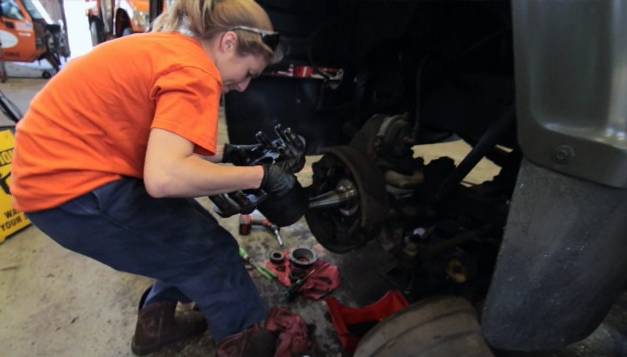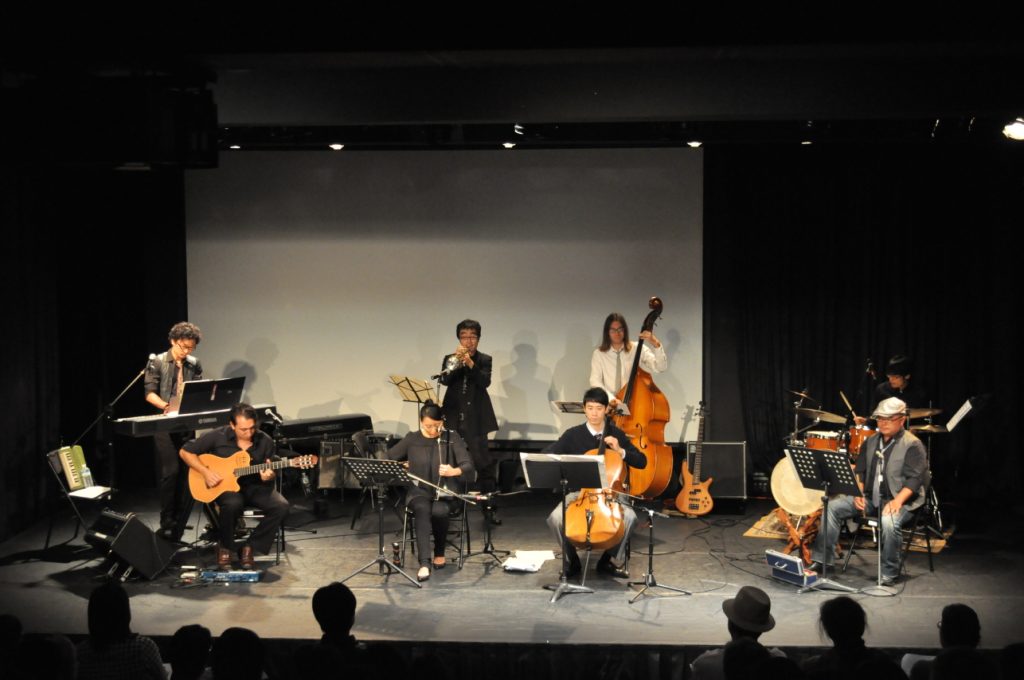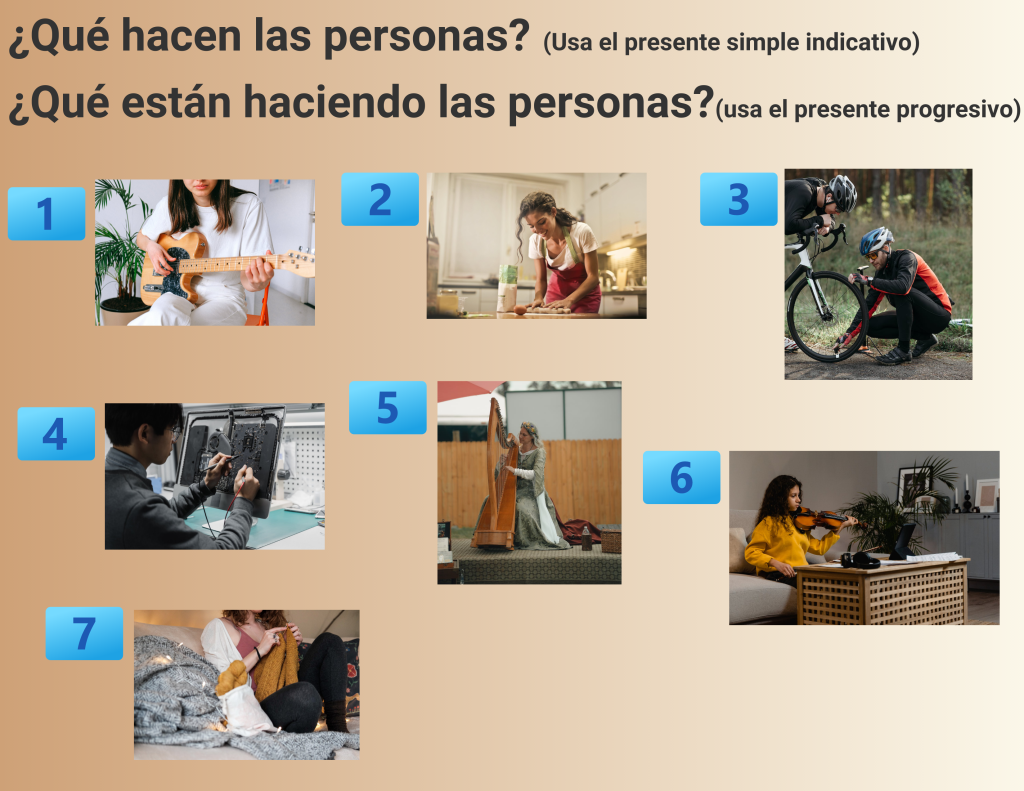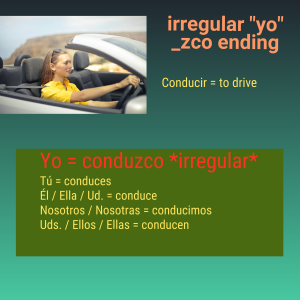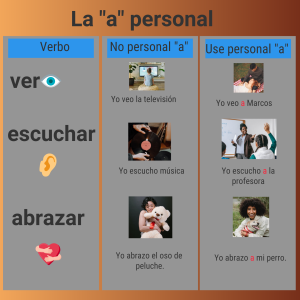Unidad 5 – Segunda Parte (Part 2)
Vocabulario
(Vocabulary)
Las habilidades y los pasatiempos (Abilities and hobbies)
1. Reparar (to fix)
Click on the list below to see la lista de vocabulario used with el verbo “reparar” and what they mean in English.
- Yo reparo carros.
2. Tocar instrumentos (to play instruments)
Click on the list below to see la lista de vocabulario used with the verb “tocar” and what they mean in English.
- Ella toca la guitarra
3. Otras habilidades (other abilities)
Click en la lista de vocabulario to learn what some abilities and hobbies mean in English.
- Nosotros tejemos una bufanda.
Cómo usarlo
(How to use it)
Usa el presente simple indicativo to talk about your current habilidades y pasatiempos.
- Mi tío Pepe repara carros porque es mecánico.
- Mi prima toca la guitarra todos los días porque ella es artista.
- Mi abuelita teje bufandas en invierno.
Usa el presente simple indicativo to talk about gustos y disgustos in relation to habilidades y pasatiempos.
- A mi tío Pepe le gusta reparar carros pero no le gusta reparar bicicletas.
- A mi prima le fascina tocar la guitarra todos los días porque ella es artista.
- A mi abuelita le gusta tejer bufandas en invierno.
- A mí me moleta tejer, pero me fascina tocar la guitarra y cantar.
Usa el presente progresivo to talk about what you and others are doing right now.
- Mi tío Pepe está reparando carros en su trabajo.
- Mi prima está tocando la guitarra porque tiene un examen de música en la noche.
- Mi abuelita está tejiendo unas bufandas para mi abuelo.
¡A practicar!
Mira las fotos que siguen y responde a las siguientes preguntas:
Copy and paste the following letters and symbols as needed.
á é í ó ú ñ Á É Í Ó Ú Ñ ¡ ! ¿ ?
El uso del verbo poder (to be able to) y las habilidades
Another good way to practice las habilidades is by talking about what we can or cannot do.
En la primera parte de la unidad 5 you learned that el verbo poder en presente simple indicativo is always followed by un verbo en infinito as it functions as an auxiliary verb just like el verbo querer.
Tú también learned that el verbo poder en presente simple indicativo carry a stem vowel-change from o to ue.
- Yo puedo tocar la guitarra, pero no puedo tocar el piano. Mi hermana puede cantar y también puede bailar. Mi hermano puede hornear y reparar computadoras. Nosotros no podemos dibujar.
¡A escuchar!
Mira el video que sigue to listen to what la mujer puede hacer y no puede hacer (can and can not do). Luego, responde las preguntas que siguen using el material learned above.
Copy and paste the following letters and symbols as needed.
á é í ó ú ñ Á É Í Ó Ú Ñ ¡ ! ¿ ?
- ¿Qué puede hacer ella?
- ¿Qué no puede hacer ella?
¿Y tú?
- ¿Qué puedes hacer tú?
- ¿Qué no puedes hacer?
Gramática
(Grammar)
1. Verbos con “yo” irregular en el presente simple indicativo
(Verbs with irregular “yo” in simple present tense)
En español some regular verbs ending in -ar, -er, -ir, carry a “yo” irregular when conjugated en el presente simple indicativo.
These verbos con “yo” irregular (irregular “yo”) se dividen en 2 categorías:
- Verbos with “yo” irregular ending in -go
- Verbos with “yo” irregular ending in -zco
When conjugating verbos regulares con “yo” irregular en el presente simple indicativo, you keep the ending you learned for either -ar, -er, -ir verbs in all subject pronouns except in “yo”.
Mira las imágenes que siguen to learn how to conjugate verbos regulares con “yo” irregular en el presente simple indicativo:
1. Verbos con “yo” irregular-go (Verbs with “yo” irregular ending in -go)
| Verb | Definition | Irregular yo | ||
|---|---|---|---|---|
| Hacer | To do, to make | hago | ||
| Poner | To put | pongo | ||
| Salir | To leave, to go outside | salgo | ||
| Traer | To bring | traigo | ||
| Valer | To value, to be worth | valgo | ||
| Caer | to fall | caigo | ||
| Satisfacer | to satisfy | satisfago | ||
| Decir | to tell | digo | ||
| Venir | to return | vengo | ||
| Tener | to have | tengo |
¡IMPORTANTE!
Mira la tabla que sigue to learn how to conjugate these verbos regulares con “yo” irregular en el presente simple indicativo:
| Decir (stem vowel-changing from e to i) | Venir (stem vowel-changing from e to ie) | Tener (stem vowel-changing from e to ie) | ||
|---|---|---|---|---|
| Yo | digo | vengo | tengo | |
| Tú | dices | vienes | tienes | |
| Ud. / Él / Ella | dice | viene | tiene | |
| Nosotros / Nosotras | decimos (no stem vowel-change) | venimos (no stem vowel-change) | tenemos (no stem vowel-change) | |
| Uds. / Ellos / Ellas | dicen | vienen | tienen |
2. Verbos con “yo” irregular -zco
(Verbs with “yo” irregular ending in -zco)
| Verb | Definition | Irregular yo | ||
|---|---|---|---|---|
| Conducir | To drive | conduzco | ||
| Conocer | To know (a person, a place) | conozco | ||
| Traducir | To translate | traduzco | ||
| Producir | To produce | produzco | ||
| Reproducir | To reproduce | reproduzco | ||
| Deducir | To deduct | deduzco | ||
| Seducir | To seduce | seduzco | ||
| Introducir | To insert, to put in | introduzco |
3. Otros verbos con “yo” irregular (Other verbs with “yo” irregular)
| Verb | Definition | Irregular yo | ||
|---|---|---|---|---|
| Dar | To give | doy | ||
| Oír | To hear | oigo | ||
| Saber | To know (information, how to do something) | sé | ||
| Ver | To see | veo |
¡A practicar!
Haz clic en el enlace de LibreText below para practicar los verbos con “yo” irregular:
LibreText actividad 4.4.1. – Práctica- Los verbos irregulares en el “yo”.
Copy and paste the following letters and symbols as needed.
á é í ó ú ñ Á É Í Ó Ú Ñ ¡ ! ¿ ?
2. Verbos Conocer y Saber (Verbs Conocer and Saber)
Unlike English, el español has 2 verbos (verbs) en infinitivo which mean To know. These verbos are Conocer and Saber.
Since conocer and saber are different verbos, they can’t be used interchangeably as they have their own specific uses.
Cómo usar Conocer
(How to use Conocer)
| Pronombres sujeto | Conocer |
|---|---|
| Yo | conozco |
| Tú | conoces |
| Usted/Él/ Ella | conoce |
| Nosotros/Nosotras | conocemos |
| Ellos/Ellas/Ustedes | conocen |
¡IMPORTANTE!
- Because in Argentina, Uruguay, Paraguay and some countries in Central America, tú changes to vos, then tú conoces will change to vos conocés.
- Because in Spain and Equatorial Guinea ustedes changes to vosotros / vosotras, then ustedes conocen will change to vosotros / vosotras conocéis.
Conocer is used to:
- Say you know a person or are acquainted with a person or persons.
- Say you know or don’t know a place or location.
- Say you are familiar with a thing or that you have some knowledge of something.
Haz clic en la (i) en las fotos below to see some examples of how to use the verb “Conocer”
Cómo usar Saber
(How to use Saber)
| Pronombres sujeto | Saber |
|---|---|
| Yo | sé |
| Tú | sabes |
| Usted/Él/Ella | sabe |
| Nosotros/Nosotras | sabemos |
| Ellos/Ellas/Ustedes | saben |
¡IMPORTANTE!
- Because in Argentina, Uruguay, Paraguay and some countries in Central America, tú changes to vos, then tú sabes will change to vos sabés.
- Because in Spain and Equatorial Guinea ustedes changes to vosotros / vosotras, then ustedes saben will change to vosotros / vosotras sabéis.
- Ask for information.
- Say you know how to do something like a skill, ability or know how to…
- Say you know information or facts.
Haz clic en la (i) en las fotos below to see some examples of how to use the verb “Saber”
¡IMPORTANTE!
Notice that when conocer is used to know a person, it is always followed by an “a”:
- Yo conozco a la profesora de inglés.
Notice that conocer is always followed by a noun:
- Miguel conoce Argentina.
- Nosotras conocemos a la presidenta de la asociación.
Notice that when saber is used to talk about abilities we know, it is always followed by an infinite verb:
- Yo sé tocar el piano.
Notice that when saber is used to give information, it is always followed by “que“:
- Yo sé que la clase de español es a las 2 de la tarde.
Notice that when saber is used to say we have knowledge about something, it is always followed by “sobre” or “de“:
- Yo sé sobre la geografía mundial.
- Juan sabe de política.
¡A escuchar!
Mira el video que sigue y usa la table below para hacer una lista de las preguntas en el video que usan saber y de las preguntas que usan conocer:
Copy and paste the following letters and symbols as needed.
á é í ó ú ñ Á É Í Ó Ú Ñ ¡ ! ¿ ?
| Saber | Conocer |
|---|---|
¡Más práctica!
- Escribe tres cosas que sabes hacer (you can use the vocab at the beginning of this unit).
- Escribe y describe tres personas que conoces.
- Escribe sobre cuatro lugares/libros/películas que conoces.
Copy and paste the following letters and symbols as needed.
á é í ó ú ñ Á É Í Ó Ú Ñ ¡ ! ¿ ?
3. La “a” personal (The personal “a”)
La “a” personal en español is used when the action of the verb is towards a person or a pet (an animate noun) but not an inanimate noun.
Mira la tabla below to grasp the use of la “a” personal:
En la tabla above we have el verbo ver (to see). In the first example, the action of the verb is toward la televisión (an inanimate noun). In the second example we are seeing Marcos (an animate noun, a person). If the noun is inanimate there is no personal “a”. If the noun is animate we use personal “a”. When used la “a” personal goes after the verb and before the noun.
¡IMPORTANTE!
Just like los verbos ver, abrazar, escuchar, el verbo conocer also uses la “a” personal when followed by una persona or an animate noun.
| No personal “a” | Use personal “a” |
| Yo conozco el parque Stanley en Vancouver. | Yo conozco a la activista guatemalteca Rigoberta Menchú. |
| ¿Cónoces tú Chile? | ¿Cónoces tú al Primer Ministro de Canadá? |
Remember that you learned before that the “a” followed by a singular masculine noun contracts to “al” as in: a+el = al. This is also the case when you are using la “a” personal.
Los estudiantes escuchan al (a+el) profesor.
Cultura hispanohablante
(Spanish-speaking Culture)
El protocolo social en restaurantes de países hispanohablantes
(Social etiquettes in restaurants in Spanish-speaking countries)
En la primera parte de la unidad 3 you learned that en español, when ordering in a restaurant, we tend to prefer polite language and the use of usted when engaging with the server en un restaurante.
Tú también learned algunas expresiones used en un restaurante. Por ejemplo:
Mira los videos que siguen to hear some of these expressions and polite language in context:
¿Sabías que…? (Did you know…?)
¡Buen provecho! es una expresión muy popular en español when people will start a meal.
Mira el video que sigue to learn Cómo usar la expresión ¡Buen provecho (how to use the expression ¡Buen provecho!)
Normas de etiqueta en la mesa latinoamericana (Norms of dining etiquette in Latin America)
Haz clic en el enlace: Dining Etiquette to learn about different dining protocols in Latin America.
En mi opinión…
Choose a Spanish-speaking country on the Dinning Etiquette website and compare it to las normas de etiqueta en la mesa in your culture or country where you live. How do they compare and contrast? Reflect in English.
Media Attributions
- Female mechanic © VTrans is licensed under a CC BY-NC-SA (Attribution NonCommercial ShareAlike) license
- People playing different instruments! is licensed under a CC BY-NC-SA (Attribution NonCommercial ShareAlike) license
- Woman knitting © Alex Green is licensed under a Public Domain license
- Las habilidades © Constanza Rojas-Primus and Ana Robles is licensed under a CC BY-NC (Attribution NonCommercial) license
- Irregular yo _go © Ana Robles and Constanza Rojas-Primus is licensed under a CC BY-NC (Attribution NonCommercial) license
- Irregular yo _zco © Ana Robles and Constanza Rojas-Primus is licensed under a CC BY-NC (Attribution NonCommercial) license
- La “a” personal © Ana Robles and Constanza Rojas-Primus is licensed under a CC BY-NC (Attribution NonCommercial) license
- Teacher in classroom © Yan Krukau is licensed under a CC BY-NC (Attribution NonCommercial) license
to fix
for example
to play an instrument, to touch
scarf
use
scarves
likes
dislikes
because
let´s practice!
look at, watch
that follow
to be able to
to want, to desire
let´s listen!
what follows, below
then
answer
to make, to do
with
are divided
images
important!
to tell
to return
to have
click on
link
infinitive, any verb or action that is preceded by the word 'to' in English is an infinitive. For example: to love, to eat, to run, to be, to believe, to follow, to laugh, etc. This means that the actions are not yet conjugated in the present tense or in any other tense.
to know (a person, a place)
to know (information, an ability)
that
about
of
make a list
more practice!
write (as a command)
to see
to hug
to listen
you - formal
you - informal
also
some, for feminine plural nouns
in my opinion

